Scouts Hone Their Survival Skills as Temperatures Fall Into the Single Digits
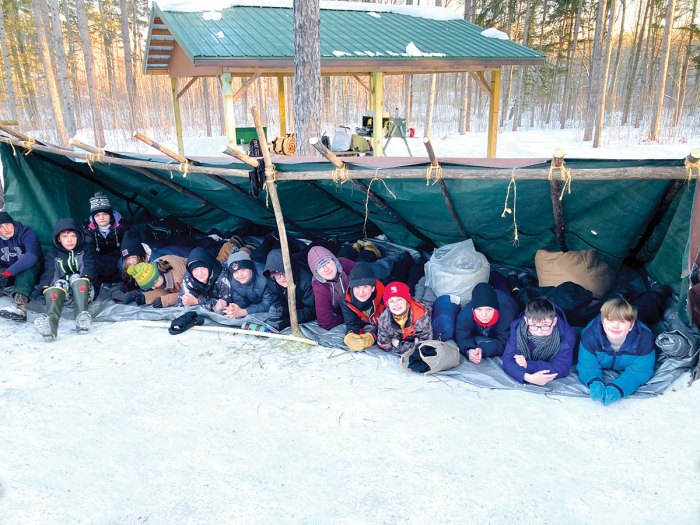
Scouts hang out under their lean-to.
Getting lost in the woods can be frightening. Now, imagine you’re lost and also standing ankle-deep in the snow as temperatures plummet below freezing. That’s downright terrifying, right?
Not if you know what to do.
For nearly a month, boys and girls troops 427 of Wausau, Wisconsin, studied winter wilderness survival skills. Then they headed out for an overnight outing in the snow. They wouldn’t really be lost, but they would practice using skills that would come in handy in case they ever were.
Surviving in February, they discovered, comes with challenges they wouldn’t have to consider in warmer temperatures.
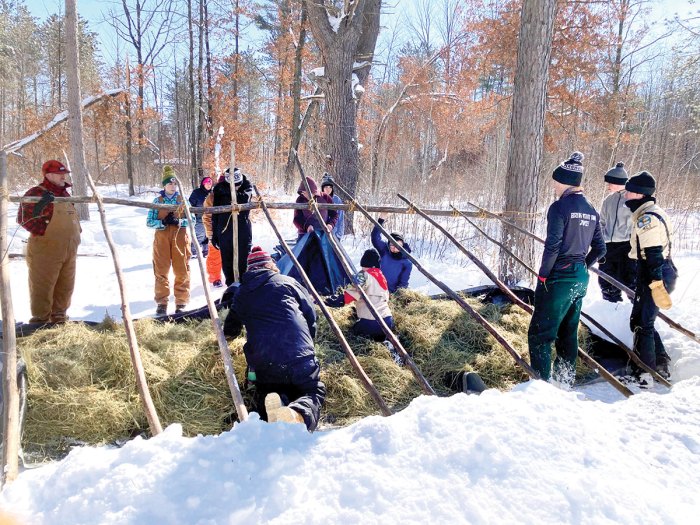
Scouts construct a lean-to shelter. They scatter straw on a large tarp and place the other half of the tarp on top to form a giant mattress.
“It’s a lot different when it’s 20 degrees outside,” says Andrew Hackel, 12, a Tenderfoot Scout.
BE PREPARED TO SURVIVE
Whenever you go camping, you don’t expect to get into a survival situation. But sometimes things go wrong when you’re outdoors. That’s why it’s vital to understand how to react in emergencies, disasters or after a poor decision.
This is called wilderness survival. Preparing for outings and knowing what to do when things don’t go as planned can help you get home safely if anything ever does go wrong.
To properly prepare for a winter outing, bring warm clothing, preferably wool. Unlike cotton fabric, wool is warm and durable, and it keeps you insulated even when wet. Synthetic blends are also a good choice for underlayers.
“You don’t want to get caught out in the snow without the gear you need,” says Joel Del Conte, 17, a Life Scout.
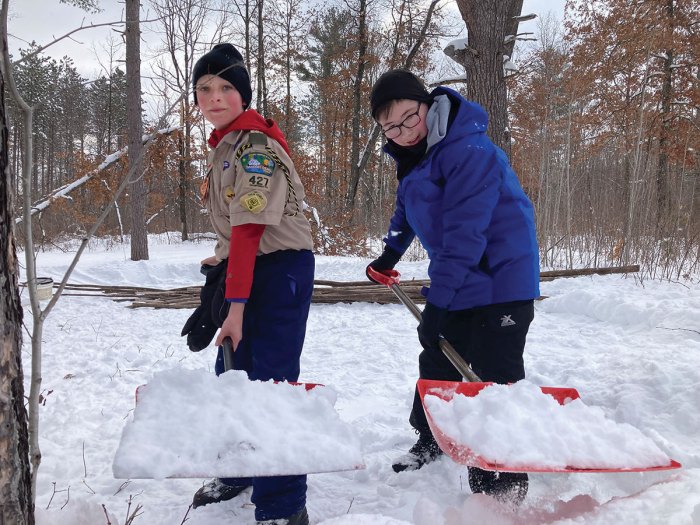
Scouts clear snow around the campfire area.
In the troop meetings leading up to the campout, the Scouts discussed what they would need and what skills they’d work on: orienteering, shelter-making and fire-building.
OUT IN THE COLD
Right before the troops arrived at the Samoset Council primitive campground in central Wisconsin, it snowed. A lot.
About a foot-and-a-half covered the entryway, preventing the troops from entering the camp.
“We had to shovel it out of the way,” Andrew says.
As soon as they got through the front gate, the Scouts began working on their shelters. After assessing your situation and rendering any necessary first aid, finding shelter should be one of your top priorities in a survival situation. The Scouts unloaded a trailer full of pioneering spars and used a sled to drag them to camp.
The first shelter would be an enormous lean-to. Setting up between three trees, the group attached spars to the trees about five feet off the ground, creating a horizontal bar. They leaned more spars against the bar, securing them using square lashings. Then they laid down a tarp and covered it with hay, which would serve as a warm, cushy mattress on top of the cold ground.
The Scouts then built a quinzee, which you can make by hollowing out a pile of snow. They used spars and a tarp to give the shelter support and structure. Creating survival shelters turned out to be more satisfying than pitching tents.
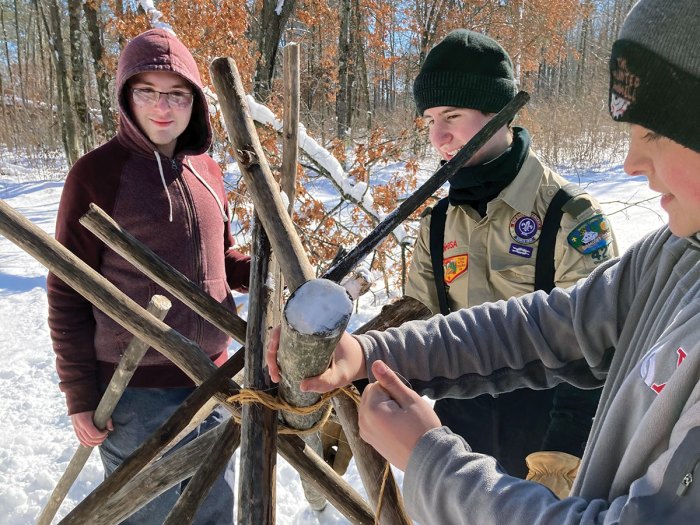
Joel Del Conte, Xavier Harl and Zachary Hackbarth lash pioneering poles together to form the skeleton of a quinzee hut.
“It’s a lot more fun to see something you built be functional,” says Carley Pease, 14, a Life Scout.
CONQUERING CHALLENGES
Building shelters wasn’t the only fun challenge that day. The adult leaders had a couple of patrol contests planned for the Scouts: an orienteering course followed by a fire-building competition. The previous week, the adults had set up the course in the woods, placing orange markers next to sandwich bags. As the Scouts took bearings and marched to each marker, they found the bags were filled with matches, birch bark and dryer lint — perfect fire-starters.
The fire-building contest required each patrol to quickly ignite a small fire underneath a piece of twine stretched nearly two feet off the ground. The objective was to feed the flames so they’d burn through the twine.
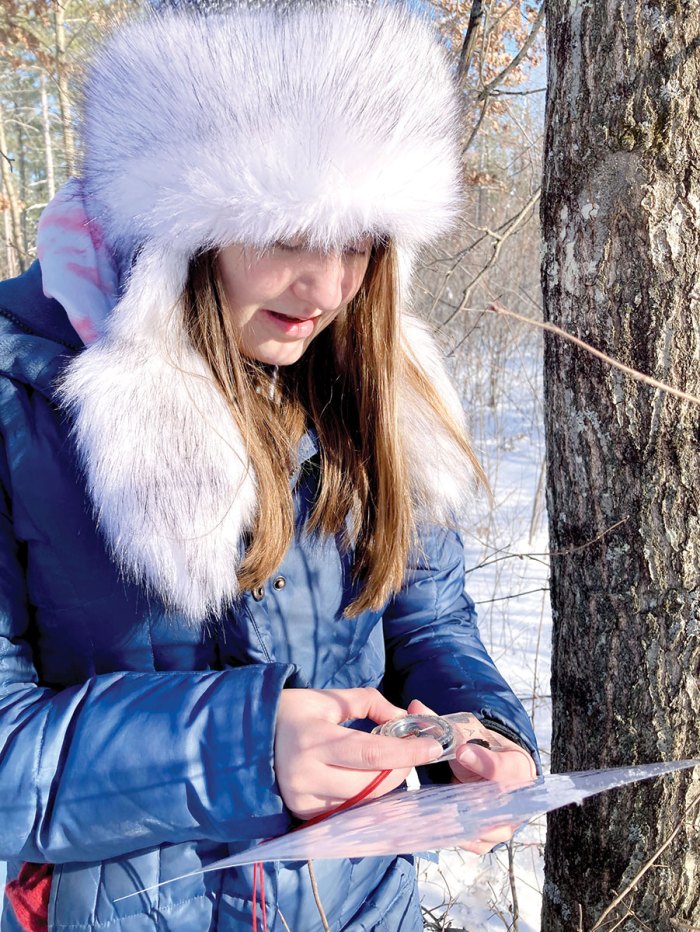
Olivia Kolton takes a bearing with a compass to find the next control point on an orienteering course.
“I think fire-building was the toughest; our fire almost went out,” Carley says.
Campfires keep you warm — and they also help you cook some tasty meals. The troops did all their cooking over an open fire, making brats and kielbasa, as well as Dutch oven beef stew and “mountain man breakfast,” a delicious combination of sausage, hash browns, eggs and cheese.
The only time the Scouts didn’t use their culinary skills was during cracker barrel, a social time at the end of the day when they sipped hot chocolate and munched on Pop-Tarts.
“That’s real survival food there!” Joel joked.

Zachary Hackbarth ties the main crossbeam of a lean-to shelter to a tree.
CHILLED OUT
As the Scouts crammed into their shelters, temperatures dropped into the single digits.
“I had to keep my saline solution for my contacts in my sleeping bag so it wouldn’t freeze,” Carley says.
Some Scouts awoke to frozen clothing. Tenderfoot Scout Michael Graveen, 11, says he and his fellow Scouts developed valuable survival skills and enjoyed spending time together.
“It was pretty fun,” he says.
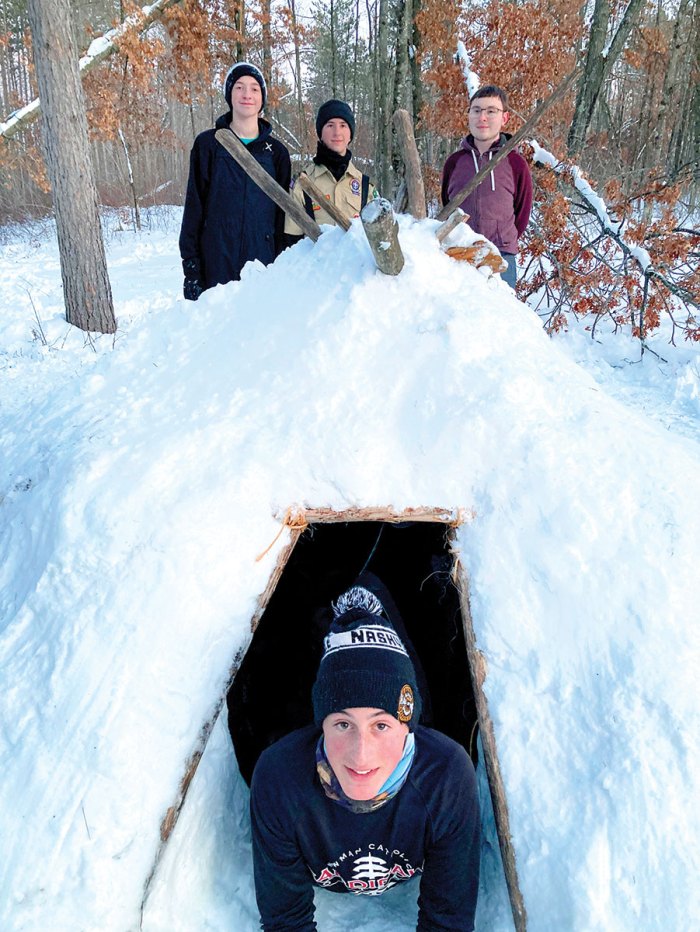
Steven Klement emerges from a quinzee the Scouts built while Evan Clawson, Xavier Harl and Joel Del Conte stand behind it. A quinzee shields you from the elements and retains your body heat, creating a comfortable place to sleep.
Treating Hypothermia
Hypothermia is a deadly situation in which your body loses heat faster than it can produce it. Warning signs of hypothermia include drowsiness, confusion, fatigue and slurred speech.
If someone is showing those signs, move the person into a building or tent. Offer them small amounts of warm liquids and get them into dry, warm clothes. Zip them up in a dry sleeping bag and cover their head with a warm hat or the sleeping bag’s hood.
Watch the person closely, and be ready to administer other first aid if needed. Seek medical care as soon as possible.
A Survival Story
During cracker barrel, the girls’ Scoutmaster read a fictional short story for the Scouts: “To Build a Fire” by Jack London. In it, a man struggles to survive in the frigid Yukon Territory.
In writing the story, London drew upon his experiences of hunting for gold in northern Canada in the 1890s. His most famous works, The Call of the Wild and White Fang, were based on that gold rush, too.
London’s connection to Scouting goes way back. “To Build a Fire” appeared in the January 1946 issue of Scout Life (then called Boys’ Life), and The Call of the Wild and White Fang are listed in Scout Life’s “100 Books That Every Kid Should Read.” Find the full list at go.scoutlife.org/booklist
I remember doing that with our troop, east of Antigo, many years ago..
Snowstorm, and winds, broken crossbeams in the tent, and had to have our bus pulled out of the drifts…
Continued studying survival afterwards, and through service.
Now, in my sixties, I still use these skills solo kayaking on lake Superior !